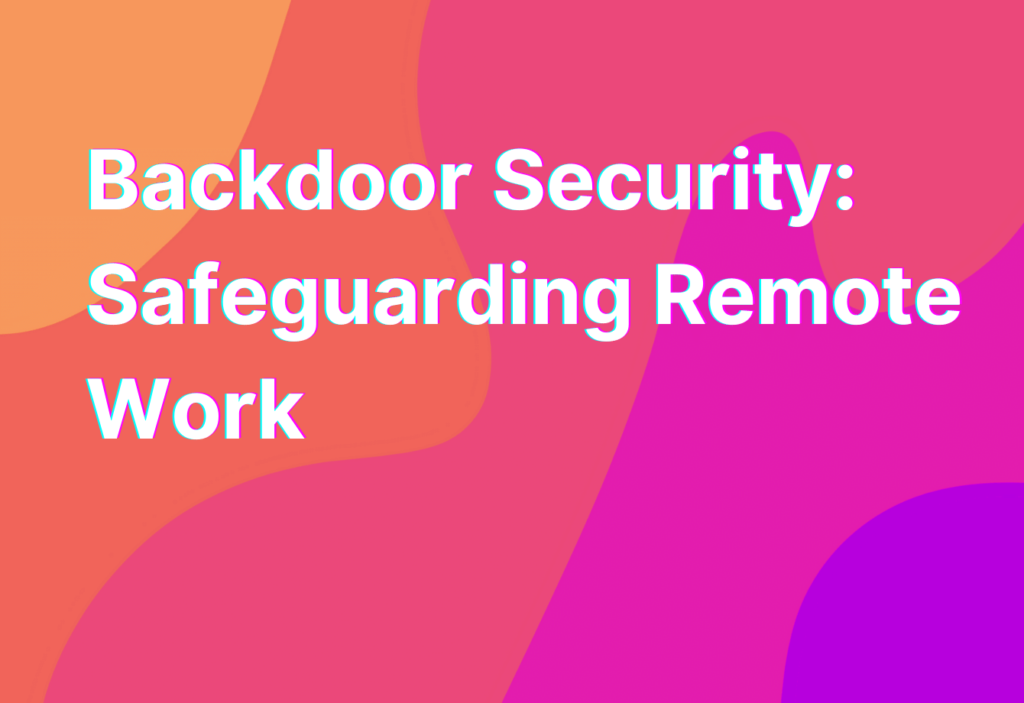Backdoor Security: Safeguarding Remote Work
Hey there, remote work warriors! It’s Ashley, your friendly neighborhood remote work advocate, back with another dose of helpful advice. Today, we’re diving into the world of backdoor security and how to keep your remote work setup safe and sound. So grab your favorite cup of coffee (or tea, if that’s your thing) and let’s get started!
What is a Backdoor?
Before we jump into the nitty-gritty of backdoor security, let’s make sure we’re all on the same page. A backdoor, in the context of remote work, refers to a hidden entry point into a system or network that allows unauthorized access. Think of it as a secret passage that cybercriminals can use to sneak into your virtual workspace without you even knowing.
Now, you might be wondering, “Ashley, how do these backdoors even exist in the first place?” Great question! Backdoors can be created intentionally by malicious actors or accidentally by software vulnerabilities. They can be found in various forms, such as hidden user accounts, unpatched software, or even compromised hardware.
The Risks of Backdoor Security Breaches
Backdoor security breaches can have serious consequences for remote workers and their organizations. Let’s take a look at some of the risks involved:
- Data Breaches: Backdoors provide an open invitation for cybercriminals to access sensitive data, such as customer information or trade secrets. This can lead to financial loss, reputational damage, and legal troubles.
- Unauthorized Access: Once inside your system, hackers can wreak havoc by stealing or manipulating data, installing malware, or even taking control of your devices. This can disrupt your work, compromise your privacy, and put your organization at risk.
- Loss of Productivity: Dealing with the aftermath of a backdoor security breach can be time-consuming and stressful. It can take days or even weeks to recover from an attack, resulting in lost productivity and missed deadlines.
- Financial Impact: Repairing the damage caused by a backdoor breach can be costly. From hiring cybersecurity experts to investing in new security measures, the financial implications can be significant for both individuals and organizations.
- Reputation Damage: In today’s digital world, trust is everything. A backdoor security breach can tarnish your reputation as a remote worker or your organization’s reputation as a whole. Rebuilding trust with clients, customers, and partners can be an uphill battle.
Protecting Against Backdoor Security Breaches
Now that we understand the risks, it’s time to arm ourselves with the knowledge and tools to protect against backdoor security breaches. Here are some essential steps you can take:
- Keep Software Updated: Regularly update your operating system, applications, and plugins to ensure you have the latest security patches. This helps close any potential backdoors that may have been discovered by software developers.
- Use Strong, Unique Passwords: Avoid using the same password for multiple accounts and make sure your passwords are complex and hard to guess. Consider using a password manager to securely store and generate unique passwords.
- Enable Two-Factor Authentication (2FA): Adding an extra layer of security with 2FA can significantly reduce the risk of unauthorized access. It requires a second form of verification, such as a code sent to your mobile device, in addition to your password.
- Secure Your Wi-Fi Network: Use a strong, unique password for your Wi-Fi network and enable encryption (WPA2 or WPA3) to prevent unauthorized users from accessing your network and potentially gaining access to your devices.
- Invest in a Reliable VPN: A Virtual Private Network (VPN) encrypts your internet connection, making it more difficult for hackers to intercept your data. It adds an extra layer of security, especially when connecting to public Wi-Fi networks.
These are just a few of the many steps you can take to safeguard your remote work setup. For a more comprehensive guide on cybersecurity best practices, check out our Cybersecurity Framework. It’s packed with valuable information and practical tips to keep you and your work safe from backdoor security breaches.
Wrapping Up
Remember, remote work is all about flexibility and freedom, but it’s crucial to prioritize security as well. By staying vigilant and implementing the right security measures, you can minimize the risk of backdoor security breaches and enjoy a safe and productive remote work experience.
That’s it for today, folks! Stay tuned for more remote work insights and advice from yours truly, Ashley. Until next time, keep those backdoors locked tight and happy remote working!


